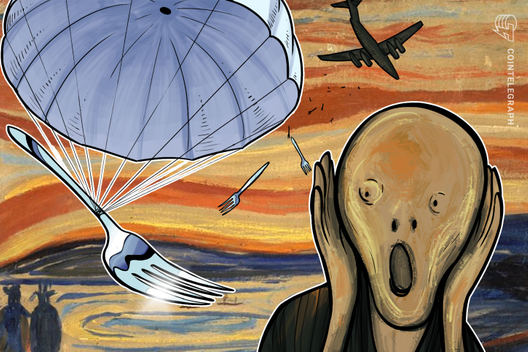In the crypto industry, there are many examples of how a conflict of interest has led to a company split. Perhaps, the largest ones are the forks of bitcoin (BTC), bitcoin cash (BCH) and the Ethereum (ETH) network. As a rule, the reason lies in disagreements related to the philosophy of the project, its development or financial components.
Various views on how the platform should be managed led to the conflict of interest at the headquarters of MakerDAO. It all started with the fact that Andy Milenius, the company’s chief technology officer, left the project, as reported by Cointelegraph on April 28. Internal conflicts have been aggravated by the recently found vulnerability and trials between the key members. How far can it go and will we witness another fundamental split in the blockchain company?
Chapter 1: Vulnerability
MakerDAO is the preeminent lending platform for the DAI stablecoin — which is dollar-pegged, no less. The MakerDAO project is also a decentralized governance platform. It is through the MakerDAO platform that MKR token holders vote for the execution of changes in the DAI lending protocol. In essence, the platform’s governance system works on the principle of granting several proposals encoded in the form of Ethereum addresses. Users vote for the proposals of their choice by freezing MKR tokens in the voting contract as pledges.
Between April 22 and 26, a critical vulnerability was discovered and analyzed on the MakerDAO platform by the security audit firm Zeppelin. The vulnerability impacted the very functioning of MakerDAO by making user funds irretrievable. By exploiting the system’s vulnerable coding, attackers could gain access to the system and freely move the tokens staked in favor of one MakerDAO governance proposal to another — perhaps even a competing proposal — and lock them in place forever. On May 6, the MakerDAO team released an appeal to its community on Reddit:
“In partnership with Coinbase and Zeppelin, the Maker Foundation has been participating in a second round of audits of the Maker Voting Contract. During this process, we discovered the need to make a critical update. […] You are advised to move your MKR out of the old contract and back into your personal wallet immediately.”
Chapter 2: Andy Milenius’s departure
What could have seemed as a routine error in code at the inception of MakerDAO turned out to be much more as the plot thickened with the sudden departure of Andy Milenius, the project’s CTO, in early April. His departure was preceded by a voluminous 24 page-long letter published on April 3, which begins with the words, “Currently, the Maker development team is going through its most difficult challenge that I have witnessed during my 3.5 years with the project.”
In his letter Milenius outlined his long-standing conflict with MakerDAO CEO Rune Christensen and the former’s attempts to usurp the platform, which began back to January 2017:
“He [Christensen] told me it was necessary that he have full unilateral control over the Dev Fund from that point forward.”
As stated by Milenius, though later Rune abandoned this idea, the whole situation led to the creation of the opposition, aimed at preventing Rune from ruining the project and at protecting the community’s funds.
Another event that affected the professional relations inside the company, according to Milenius, was the appearance of Matt Richards, who, in the spring of 2017, assumed the responsibility of the chief operating officer. According to Milenius, Richards was not only not familiar with the technical side of the project, but did not support the very idea of DappHub, the separate project led by the MakerDAO developers and initiated by Christensen to better manage the company’s processes. In addition, his invasion of the project interfered with the work of designers and developers, which soon led to internal conflicts and affected the platform’s development:
“Matt especially hated the concept of DappHub. He thought it was an unprofessional arrangement and also seemed to feel personally insulted that they wanted to remain an entity separate from the organization he was trying to create. He would ask me countless times to explain to him why they felt culturally distinct from him and why couldn’t they just be a part of the “family” he so desperately wanted us to be. […] I had told the DappHub developers to let me handle the business of dealing with Maker because I knew they would only get stressed out by Matt. This advice ended up being a huge mistake, as the core dev team was not around to object to the organizational decisions he was making until it was far too late.”
As the situation got worse, Milenius requested Christensen to fire Richards:
“I told him that Matt was consistently a distraction and wasted my time by proposing stupid ideas that needed constant rebuttal. I told him Matt’s opinion that the core developers were ‘my developers’ was preposterous and that I refused to control them and get them to ‘report’ to me like he wanted. I told him that Matt had done a lot of good for the project but that it was time for him to go.”
However, even with Richards’s departure, the atmosphere inside the company did not improve. According to Milenius, Christensen was dissatisfied with the work of key developers — and they, in turn, tried to resist his attempts to monopolize the developers fund and spend all the money on his strategic initiatives.
“They [the developers] said it was unfair that Rune gets to spend the entire Dev fund on his strategic initiatives. […] They said Rune shouldn’t be able to monopolize access to the Dev fund like that because he isn’t a god and other people might have differing points of view or priorities.”
As the conflict inside the company smouldered further and involved new people, more and more people began to disagree with the way Christensen tried to take control of the decentralized autonomous organization (DAO), with the result that the main project developers from DappHub stopped cooperating. As stated by Milenius, his ideas of equal working space and democratization inherent in DAO, and the desire of his fellow executives to traditional corporate efficiency hadn’t been accepted by Christensen. Later, Milenius confirmed to the media that he is no longer the technical director of MakerDAO.
“The purpose of the Maker Foundation was to formalize existing social relations in the Maker community. It is currently failing at this purpose and needs to be corrected at the fundamental level.”
Chapter 3: The opposition
The charade of departures from the company’s board has so far been focused on preventing the consolidation of power in the hands of Christensen. When the company’s infrastructure expanded and disagreements began to arise, Christensen offered the developers two options for cooperation: the Red Pill and the Blue Pill.
Those who chose Red Pill were supposed to work for him inside the Maker Ecosystem Growth Group (MEGG) on the initiatives that “he was going to eventually document in the much-promised Strategic Plan.” The tasks were aimed at delivering government compliance and integrating Maker into the existing global financial system. The Blue Pill was prepared for those who didn’t want to work on those initiatives. Their primary duty was the implementation of Multi-Collateral DAI (MCD) core contracts needed to launch a fully autonomous system, after which their relationships with the company would cease.
According to Milenius, nobody accepted those binary options since they conflicted with the main idea of the decentralized company. General discontent led to the creation of an opposition group that called itself the Purple Pill in March 2018. Members include former MakerDAO business development executive Ashleigh Schap, who proclaimed that they aimed to make the company more decentralized. Schap, who has allegedly created the group, is now suing MakerDAO in a $1 million lawsuit.
The real aim of the pseudo-Matrix saga, Blue and Red Pill amalgamation in the form of the Purple Pill faction was to dethorne Christensen and take control of the $200 million fund. So far, Purple Pill has been brewing its plots and accusations in the Signal chat with former members of the team:
“The name Purple Pill was chosen because the hope was that there was a third way available to break up this binary choice. They thought this was an earnest attempt to add resiliency to the overall Strategic Plan.”
In his letter, Milenius claims that many people, including board members, were added in the group after they agreed that the third way was desirable. At the same time, the creators and participants of the group pursued exclusively positive goals, wishing to save the organization and prevent the consolidation of funds in the hands of one person:
“No one thought about the fact that they were board members, they just wanted to talk because these were some of the most senior and respected contributors in the project.”
As the Purple Pill group was growing, tension was also rising on the Foundation Board. Christensen requested a large amount of MKR tokens from the Foundation Board for allegedly funding and expanding operations. When the members asked for more transparency and requested documents that could confirm his demands, he was surprised. This event could also become the reason why he later accused board members of conspiracy, when he found out there was a Signal group:
“He couldn’t believe that people would treat him this way when he had broken his back working day and night for this project, sacrificing his own personal happiness and health like so many other entrepreneurs do. He had been under so much pressure for so long trying so hard to make this work that when he discovered the group, he snapped. Conspiracy. Corruption.”
As a result, some board members who participated in the Purple Pill group were fired.
Chapter 4: Here comes Campbells
MakerDAO has seen its fair share of woes, and they were only aggravated when five of the nine board members requested the Campbells law firm for assistance after they had been forced by Christensen to leave the company.
David Currin, Denis Erfurt, Thomas Pulber, James Reidy and Kenny Rowe wrote a collective letter in an effort to contest the accusation made by Christensen and to prove their innocence. The expansive letter contains their collective confession that all five had been doing their jobs, a denial of conspiracy against the foundation’s management and statements about sullied reputations.
The letter also refers to the Purple Pill affair. All five claim that the discussions were neither conspiratorial nor clandestine, and involved a large group of people engaged in the project in various capacities, exploring ideas with a shared goal of protecting and advancing the project.
The letter reveals that on March 22, 2019, the general counsel at MakerDAO, Brian Avello, contacted the five former board members via email with a request to attend a meeting regarding “urgent things on the regulatory front.” The meeting was a pretext for the CEO to confront the five regarding the Purple Pill group and demand that they either resign voluntarily or be removed as directors of the foundation.
The accusations thrown at the five by Christensen were quite weighty, ranging from conspiracy to corruption, placing the project at risk and scheming to breach their duties.
While none of the five case participants replied to a request for a comment, it remains to be seen how the drama with legal action will unfold.
Chapter 5: Matt Richards replies to Andy Milenius’s letter
On April 27, Richards published an answer to Milenius’s accusations in a Reddit thread — thus, providing a chance to address the story from a different angle. In particular, he acknowledged the mistakes he made while working as the MakerDAO COO and noted that, relying on the fact that all members of the company were acting out of good intentions, he did not take into account the growing disagreements of the staff of MakerDAO, instead of working under a single aegis.
Richards also referred to Milenius as the person who was mainly interested in technical nuances and coding, rather than in the project’s development:
“According to Andy, no amount of accountability was acceptable, the efficiency that came with explicit hierarchy did not outweigh how uncool or unfair it was, MKR investors interests were of little consequence, the dev fund was for “hacker aesthetics, development tools, Free Software, grassroots empowerment, memetics, the Unix Design philosophy and especially the political implications of decentralized technology. […] And if Maker’s vision was built as a by-product, cool.”
Being less eloquent than Milenius, Richards ended his post with optimistic forecasts about the future of MakerDAO:
“I am hopeful about the future of this project and believe it will likely be better off without Andy.”

Community’s reaction
The situation may look intriguing if viewed from the point of those truly affected by the scandal and the system vulnerabilities — the MakerDAO community, namely because it is their money at stake. The multiple comments left by Reddit users under Richard’s letter are examples of irony and emotional upheaval. The community’s reaction is best described by a comment left by a user nicknamed “ShiIl,” who stated:
“Like the Greek dramas of old, there is no real bad guy here, just people doing their best with varying motivations.”
Other users referred to the idea of decentralization and pointed out that, in such corporations, the control shouldn’t be accessed by only one person:
“The whole point of this thing is to avoid trusting one individual! Even if Rune is a saint, the whole point is can’t be evil not don’t be evil.”
Meanwhile, there are some users who found nothing unusual in the situation:
“This seems like a rather typical situation of a CEO trying to run a business and deliver value to investors while the CTO constantly gets distracted by ‘cool’ features which don’t drive revenue. It’s a common issue in many companies and generally the result of having a CTO who is technically skilled but lacks business acumen. Such people should not be given leadership positions in a technical team. The goal of the CTO is to build the tech the company needs, not the tech they want.”
Consequences
The biggest risk thus far is the vulnerability found in the system, since it could be only a matter of time before someone, somewhere tries to take advantage of it. The company has already announced that it has developed a fix together with Zeppelin and the implementation of it was underway. But the internal power struggle within the company remains the most worrying aspect of the entire conundrum surrounding MakerDAO. If the team continues the conflict, then these issues may soon eclipse any of the technical difficulties the company has — and the community may have the last say on the matter.









